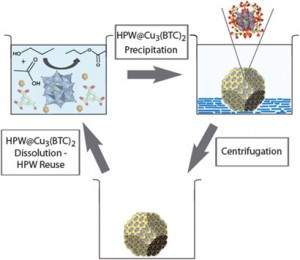This month sees the following articles in Chemical Science that are in the top ten most accessed:-
Copper(i)-catalyzed intramolecular [2 + 2] cycloaddition of 1,6-enyne-derived ketenimine: an efficient construction of strained and bridged 7-substituted-3-heterobicyclo[3.1.1]heptan-6-one
Bao-Sheng Li, Bin-Miao Yang, Shao-Hua Wang, Yong-Qiang Zhang, Xiao-Ping Cao and Yong-Qiang Tu
Chem. Sci., 2012, Advance Article, DOI: 10.1039/C2SC20109G
Hindered Biaryls by C-H Coupling: Bisoxazoline-Pd Catalysis Leading to Enantioselective C-H Coupling
Kazuya Yamaguchi, Junichiro Yamaguchi, Armido Studer and Kenichiro Itami
Chem. Sci., 2012, Advance Article, DOI: 10.1039/C2SC20277H
Asymmetric Catalytic Epoxidation of α, β-Unsaturated Carbonyl Compounds with Hydrogen Peroxide: Additive-Free and Wide Substrate Scope
Yangyang Chu, Xiaohua Liu, Wei Li, Xiaolei Hu, Lili Lin and Xiaoming Feng
Chem. Sci., 2012, Advance Article , DOI: 10.1039/C2SC20218B
Chemical sensing with shapeshifting organic molecules
Kimberly K. Larson, Maggie He, Johannes F. Teichert, Atsushi Naganawa and Jeffrey W. Bode
Chem. Sci., 2012, Advance Article, DOI: 10.1039/C2SC20238G
Asymmetric C(sp3)-H/C(Ar) coupling reactions. Highly enantio-enriched indolines via regiodivergent reaction of a racemic mixture
Dmitry Katayev, Masafumi Nakanishi, Thomas Bürgi and E. Peter Kündig
Chem. Sci., 2012, Advance Article, DOI: 10.1039/C2SC20111A
N-rich zeolite-like metal-organic framework with sodalite topology: high CO2 uptake, selective gas adsorption and efficient drug delivery
Jun-Sheng Qin, Dong-Ying Du, Wen-Liang Li, Jing-Ping Zhang, Shun-Li Li, Zhong-Min Su, Xin-Long Wang, Qiang Xu, Kui-Zhan Shao and Ya-Qian Lan
Chem. Sci., 2012, Advance Article, DOI: 10.1039/C2SC00017B
Dialkylbiaryl phosphines in Pd-catalyzed amination: a user’s guide
David S. Surry and Stephen L. Buchwald
Chem. Sci., 2011, 2, 27-50, DOI: 10.1039/C0SC00331J
Synergistic catalysis: A powerful synthetic strategy for new reaction development
Anna E. Allen and David W. C. MacMillan
Chem. Sci., 2012, 3, 633-658, DOI: 10.1039/C2SC00907B
Practical and scalable catalytic asymmetric α-amination of carboxylic acids using isothioureas
Louis C. Morrill, Tomas Lebl, Alexandra M. Z. Slawin and Andrew D. Smith
Chem. Sci., 2012, Advance Article, DOI: 10.1039/C2SC20171B
Estimating chemical reactivity and cross-influence from collective chemical knowledge
Siowling Soh, Yanhu Wei, Bartlomiej Kowalczyk, Chris M. Gothard, Bilge Baytekin, Nosheen Gothard and Bartosz A. Grzybowski
Chem. Sci., 2012, 3, 1497-1502, DOI: 10.1039/C2SC00011C
Why not take a look at the articles today and blog your thoughts and comments below.
Fancy submitting an article to Chemical Science? Then why not submit to us today or alternatively contact us with your suggestions.

















